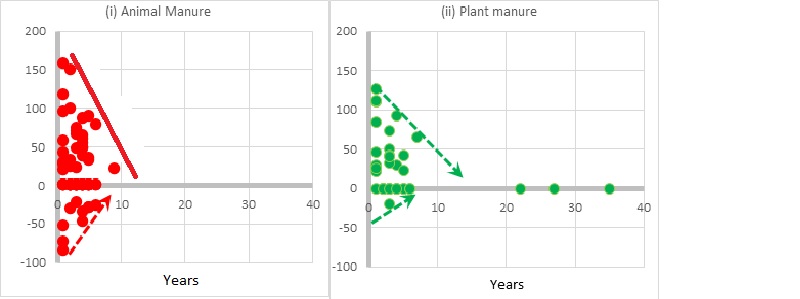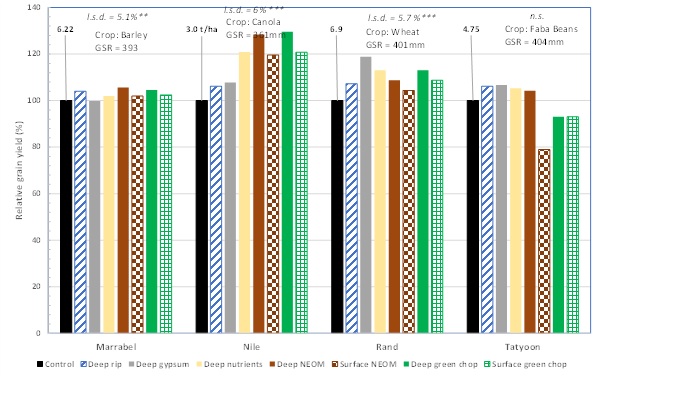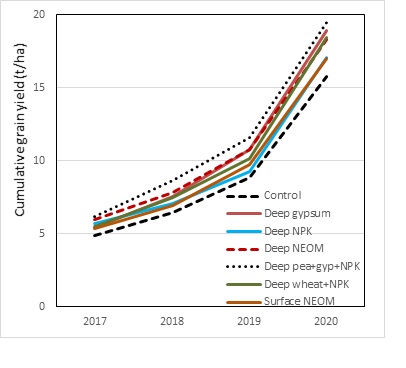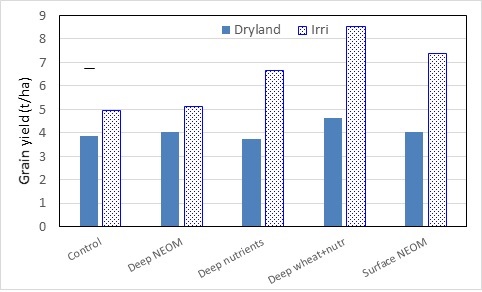Subsoil amelioration - update on current research
Subsoil amelioration - update on current research
Author: Roger Armstrong, Murray Hart, Ehsan Tavakkoli, Shihab Uddin, Nigel Wilhelm, Geoff Dean, Brian Hughes and Peter Sale. | Date: 24 Feb 2021
Take home messages
- Long-term trials throughout south eastern (SE) Australia indicate plant-based manures improved grain yields by an average of 19%. Animal manures improved yields by an average of 26% but can also produce negative effects with a trend for the residual benefits to be shorter-lasting than for plant-based amendments.
- Responses to amelioration are strongly influenced by water availability (subsoil reserves, seasonal rainfall patterns and potentially water logging).
- Responses to amelioration with organic materials appear soil type specific requiring an assessment of both subsoil and topsoil soil properties, including dispersion.
Background
Current grain yields in many sections of the high rainfall zone (HRZ) of SE Australia, as well as parts of the medium rainfall zone (MRZ) remain below water limited yield potential. This failure to achieve yield potentials have been attributed to a range of factors including nitrogen (N) deficiency, disease and seasonal conditions including frost (Armstrong et al. 2019; Hochman et al. 2019). Many soils in this region also contain a range of physicochemical constraints, especially in subsoils which limit root growth and efficient use of soil water and nutrients (Adcock et al. 2007).
Previous research including that by Peter Sale and his colleagues at La Trobe University, summarised in Sale et al. (2021), have recorded significant yield benefits from the application of animal-based manures to subsoils (referred to as ‘subsoil manuring’), especially in HRZ systems. Despite the strong interest in this approach by some growers, overall rates of on-farm adoption currently remain very low. This lack of adoption has been attributed to several major logistical constraints including an inability to source sufficient quantities (at a low price) of ameliorant stock, particularly animal manures, and a lack of suitable commercial scale machinery for placing the ameliorants into the soil (Nicolson 2016). Most importantly the unpredictability of grain yield responses (‘when, where, how much and how long’) mean that most growers are not willing to undertake the significant financial risk resulting from the initial high upfront investment (approximately $1200-1400/ha (Sale and Malcom 2015)) needed.
In 2017, two major projects commenced with the support of GRDC investment, examining the use of soil amelioration to improve long-term crop productivity: one project focused on sandy soils in the low rainfall zone (LRZ) (CSP00203) and the other on clay soils in the HRZ and MRZ of SE Australia (DAV00149). This presentation provides an update on some of the latest research arising from DAV00149.
Method
Analysis of long-term trials
An analysis was undertaken of a large number of field-based trials (greater than 70) that have been undertaken over recent years by different groups under a variety of initiatives in SE-Australia comparing different combinations of plus/minus deep ripping, with and without the use of amendments including animal manures, plant biomass and gypsum and different placement (surface or subsoil). Several criteria were used to determine which trials should be included in the analysis, including presence of an unamended ‘control’, an ability to track the providence of the trial (including when the trial was commenced) and an ability to accurately locate plots. A response was only recorded if statistically different (P = 0.05) or if no replication was used the response had to be greater than 20%. There were 40 trial years of data for legume organic matter (comprising 14 sites but with only six of these trials with data older than five years) and 71 for animal manure (comprising 20 sites but with only five sites older than five years). The majority of trials (55%) were sown to cereals (wheat and barley). This analysis was then used to graph the relative grain yield response to either the application of animal manure or legume amendments to the subsoil compared to the non-amended control.
The effectiveness of different amendments and placement strategies
A network of ‘new field experiments’ were established (two in 2017 and another six in 2018) with four located in the HRZ (Rand, New South Wales (NSW); Nile, Tasmania; Tatyoon, Victoria and Marrabel, South Australia (SA)) and four in the MRZ (Grogan, NSW; Condowie in SA and Kiata and Plant Breeding Centre (PBC) (Horsham) in Victoria). The equivalent of 20t/ha of organic amendment was applied at HRZ sites (except for Marrabel where 15t/ha was applied) and 15t/ha at MRZ sites. All experiments had a common set of amelioration treatments (as well as additional ones of local interest) including a deep-ripping ‘check’, surface and subsoil application of animal manure, legume plant based amendment and gypsum. In addition, all experiments had a nutrient only treatment (phosphorus (P) plus N rates equivalent to 50% of that contained in organic material with supplementary N applied over the subsequent three crops. This strategy accounted for a predicted 50% mineralisation rate of N from the amendment each year so that the sum of N applied was equivalent to that in the organic material after three years) and a treatment comprising wheat straw plus nutrients. Amendments were applied once so that the residual value could be assessed in subsequent years.
Subsoil water and response to amendments
The effect of subsoil water on crop response to amelioration treatments was assessed by establishing irrigated subplots (1.6m wide x 2.7m long) in five treatments (control, deep nutrients, topsoil nutrient enriched organic matter (NEOM), subsoil NEOM, wheat plus nutrients) in the PBC DAV00149 experiment in March 2020 using gravity-fed drip irrigation. A total of four irrigation events were applied, each equivalent to 46mm. Changes in profile soil water balance (using neutron probes), dry matter and normalised difference vegetation index (NDVI) throughout the growing season and grain yield were monitored in the irrigated subplots and compared to adjacent dryland main plots.
Results and discussion
Analysis of long-term trials
Grain yields were improved by an average of 19% following application of plant based (legume) amendments into the subsoil across a range of soil type and environments compared to the control (no amendment) (Figure 1). In many cases the plant manure produced a marked improvement in dry matter production, but this did not translate to a response in grain yield. In contrast animal manures improved yields on average by a greater amount (26%) but produces strong negative effects on yield at several sites, whereas organic amendments produced a negative effect in one case only. Furthermore, although influenced by a small number of sites, there appeared to be a trend for the residual benefits of applying plant-based amendments into the subsoil to last longer whereas the residual benefits of the animal manures were somewhat shorter term. There were very few positive benefits (3 out of 18) in grain yield to deep ripping alone (data not presented). Four sites produced large negative responses to ripping. The overall net effect was that overall ripping alone did not change crop productivity.
Although these findings were based on both replicated and non-replicated trials, they indicate the same general trends observed to date in ‘new field experiments’ reported later. Two major barriers to the widespread commercial scale adoption of soil amelioration is the lack of sufficient quantities of animal manures. This analysis suggests that plant based (predominantly legume) manures are nearly as effective as the animal manures. As well as being more readily available, the use of plant manures potentially reduces the financial risk associated with subsoil manuring as there were no marked negative impacts that can occur with animal manures, especially in medium rainfall systems and there was a trend towards a much longer residual benefit which is critical to offsetting the initial high upfront costs of subsoil amelioration.

Figure 1. Relative grain yield response of crops to (i) application of animal manure and (ii) plant- based manures in a series of long-term fields in SE Australia.
The effectiveness of different amendments and placement strategies
No positive yield responses to amendments were recorded in 2020 at either Condowie (SA) nor Kiata (Victoria), reflecting continued low growing season rainfall (GSR) experienced at these sites since 2017 and 2018, respectively (data not presented). There were significant (P<0.05) grain yield responses recorded at Grogan, NSW (GSR = 426mm) where wheat straw plus nutrients was 15% and deep gypsum was 11% greater than the control (7.2t/ha of wheat) respectively and at the PBC (Victoria) site (GSR = 287mm; Decile 7) where deep manure and deep wheat straw plus nutrient were 11% greater (P<0.05) than the control (barley = 5.1t/ha). This yield response at Grogan, which corresponded with high GSR, contrasts with previous seasons where crops have been cut for hay due to frost and dry seasonal conditions.
Prior to 2020 there have been large (20 to 65%) yield responses to soil amendment at all HRZ sites with the exception of Tatyoon (Victoria), where responses were small (15%) or less. In 2020 for the three sites harvested to date, treatment effects were much smaller with a small treatment effect (P=0.01) at Marrabel (barley yield of control was 6.22t/ha; GSR = 393mm) and no significant effect at Tatyoon (average faba bean yield of 4.75t/ha; GSR = 404mm). In contrast, at Rand (NSW), where GSR = 401mm, had significant grain yield (P<0.001) responses to deep gypsum (19%) and deep wheat straw plus nutrients (20%) compared to the control (wheat = 6.9t/ha). Although overall responses were smaller in 2020 than in the previous three seasons (highest yield treatment from deep gypsum was 20% greater than the control), the pattern of treatment differences remained, since the experiment commenced in 2017, with an average of greater than 23% for the most productive treatments compared to the control (Figure 3).

Figure 2. Relative grain yield response (%) to soil amendments (Control = 100%). Data is for the HRZ Tatyoon, Rand and Marrabel sites in 2020 and Nile in 2019 (2020 Nile trial had not been harvested at time of writing). Value above Control represents grain yield (t/ha). GSR = growing season rainfall.

Figure 3. Cumulative grain yield responses to selected amendment treatments at Rand for 2017 (barley), 2018 (wheat), 2019 (canola) and 2020 (wheat).
Subsoil water and response to amendments
Since project experimentation commenced in 2017, the largest (on both an absolute and relative scale) crop biomass and grain yield responses have been recorded in the HRZ rather than MRZ. Prior to 2020, of the nine MRZ site x year trials conducted to date, the highest annual and growing season rainfall had been decile 5 (at PBC in 2019) with most sites recording Decile 2 to 3. In this time, no MRZ site has recorded significant subsoil water reserves prior to sowing.
At sowing (in May 2020) at PBC, the irrigation produced significant increases in volumetric soil water content to depths greater than 80cm. Interestingly, there was a trend for this increased water to reach lower in the soil profile in amended treatments (applied to both topsoil and subsoil) compared with the irrigated control treatments (data not presented).
In the absence of subsoil water reserves, there was no significant difference (P<0.05) in wheat grain yield between soil treatments (mean = 4.05t/ha, dryland treatments) (Figure 4). In the irrigated microplots, grain yield increased on average by 2.48t/ha (61%). The impact of irrigating varied with the type of amelioration imposed, ranging from 28% in the control and Deep NEOM to 78% with Deep nutrients and 84% for both Deep wheat plus nutrient and Surface NEOM. The highest grain yields (8.51t/ha) were recorded for Deep wheat plus nutrient treatment. Differences in grain yield were reflected in total wheat biomass with a trend of lower harvest index in irrigated microplots (P=0.073).

Figure 4. Effect of irrigation (prior to sowing) on grain yield responses of barley to soil amelioration (PBC, 2020). Vertical bar represents l.s.d (P=0.05 = 1.01 t/ha) for interaction between amendment and irrigation.
Conclusion
The use of plant (legume) biomass appears to offer important advantages over animal manures when ameliorating clay subsoils in the MRZ and HRZ, because of the absence of potential negative impacts on grain yield and potentially longer residual value. Importantly, plant-based manures are generally easier to source than animal manures. Results over the past two years from several of the new field experiments in DAV00149 indicate that not only are legume residues effective but that applying wheat straw plus nutrients into subsoils can significantly improve grain yields.
Grain yield responses to soil amendment on these clay soils appear to be strongly influenced by soil water supply, with poor treatment responses in very dry seasons when there is very little subsoil moisture (as evidenced by the majority of MRZ experiments to date), or very wet seasons when crops can access sufficient moisture from the topsoil (as occurred at Tatyoon and Marrabel in 2020). Controlled environment experimentation has shown that the application of subsoil manures or nutrient rich plant-based materials can improve wheat growth in water-logged soils, possibly due to a reduction in soil redox potential. There was evidence that the presence of subsoil water appears to influence response to amendments. Soil amelioration can affect crop productivity by overcoming physicochemical constraints – nutritional, poor structure and potentially toxicities such as water logging, occurring in both the topsoil and subsoil. The effect of subsoil water on amendment response is not surprising given that subsoil water has the potential to produce twice the grain yield per mm of water used compared to surface soil water (Lilley and Kirkegaard 2007) and the finding that subsoil constraints can only limit grain yields when crops are reliant on subsoil water to realise yield potentials (Nuttall and Armstrong 2010).
Acknowledgements
The research undertaken as part of the project, DAV00149 is made possible by the significant contributions of growers through both trial cooperation and the support of the GRDC. The author would like to thank them for their continued support. The authors would also like to thank Agriculture Victoria, NSW DPI, SARDI and TIAR for their ongoing support.
References
Adcock D, McNeill AM, McDonald GK, Armstrong RD (2007) Subsoil constraints to crop production on neutral and alkaline soils in south-eastern Australia: a review of current knowledge and management strategies. Australian Journal of Experimental Agriculture. 47, 1245-1261.
Armstrong R, Perris R, Munn M, Hekmeijer P, Dunsford K, Bell K, Waldner F, Hochman Z (2019) Relative importance of various factors on the water use efficiency of wheat in western Victoria. GRDC Grains Research Update, Bendigo
Hochman Z & Horan H (2018). Causes of wheat yield gaps and opportunities to advance the water-limited yield frontier in Australia. Field Crops Research 228, 20-30.
Lilley JM and Kirkegaard JA (2007) Seasonal variation in the value of subsoil water to wheat: simulation studies in southern New South Wales. Australian Journal of Agricultural Research 58, 1115-1128.
Nicholson C (2016) Business case for investment in subsoil modification with organic material. Prepared for Southern Farming Systems, as part of the National Landcare Project, INNOV-108.
Nuttall JG and Armstrong RD (2010) Impact of subsoil physicochemical constraints on crops grown in the Wimmera and Mallee is reduced during dry seasonal conditions. Australian Journal of Soil Research 48, 125-139.
Sale P & Malcom B (2015) Amending sodic soils using sub-soil manure: economic analysis of crop trials in the high rainfall zone of Victoria. Australian Farm Business Management Journal 12, 22-31
Sale P, Tavakkoli E, Armstrong R, Wilhelm N, Tang C, Desbiolles J, Malcolm B, O’Leary G, Dean G, Davenport D, Henty S and Hart M (2021). Ameliorating Dense Clay Subsoils to Increase the Yield of Rain-fed Crops. Advances in Agronomy, Volume 165 In Press.
Contact details
Prof. Roger Armstrong
Grains Innovation Park, 110 Natimuk Rd, Horsham Victoria
0417 500 449
roger.armstrong@agriculture.vic.gov.au
GRDC Project Code: DAV1606-001RMX,
